The Complete Guide to Emoji SEO: What Marketers Need to Know
Emojis, those little expression icons or chat symbols, have become the new norm for casual and business texts, social media chats, and online forums.
However, only a few of us know that they improve not only the visual perception of the content, but also search visibility and rankings. In other words, emojis serve humans and search engines alike, paving the way to a new branch of digital marketing — emoji SEO.
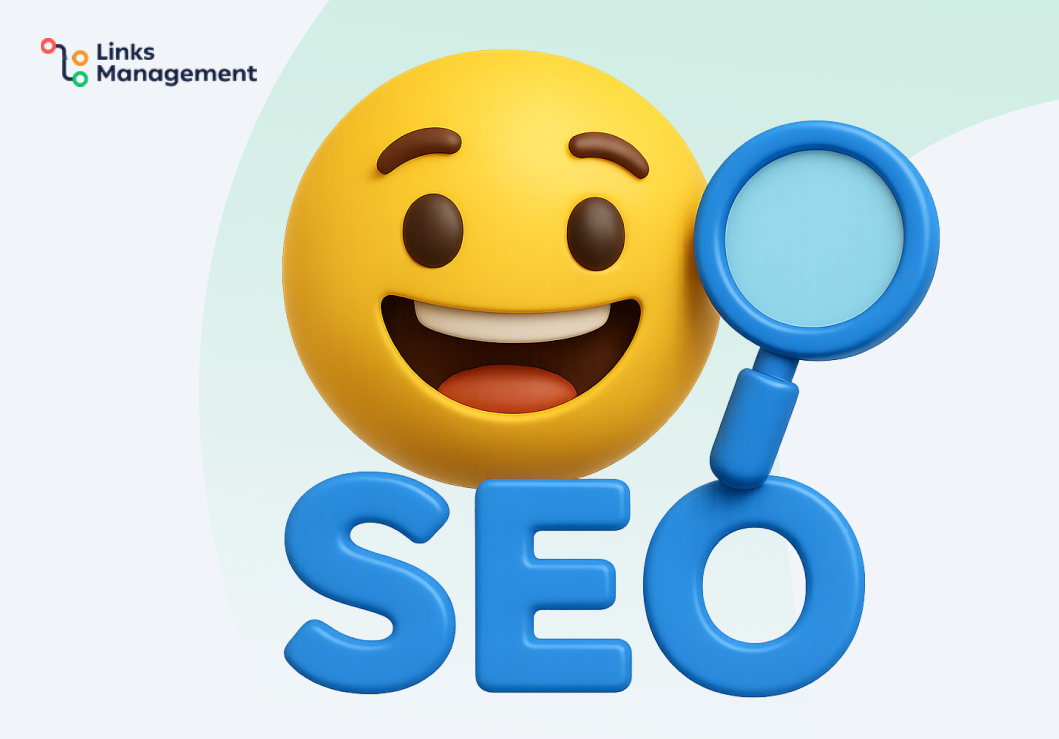
This guide will leave no stone unturned in this fascinating and emotionally charged topic. We’ll tell you how search engines like Google evaluate the use of SEO visuals, explain how to optimize your content for them, and help you avoid common mistakes.
Buckle up! We’re about to unpack the magic of emoji SEO!
Contents
- What Is Emoji SEO and Why It Matters
- How Search Engines Interpret Emoticons
- Optimizing Content with Emojis: 8 SEO Strategies That Work
- 1. Using Symbols in Meta Titles and Descriptions
- 2. Testing Emojis in Ad Copy and Rich Snippets
- 3. Crafting Emotionally Driven Headlines with SEO Symbols
- 4. Incorporating Emojis in Schema Markupns
- 5. Adding Emojis to Social Share Titles for Higher Engagement
- 6. Optimizing Emoticons for Mobile-First Search Experiences
- 7. Using Emojis in FAQ and How-To Schema
- 8. Combining Chat Symbols with Power Words for Emotional Triggers
- Tools for Emoji Search Engine Optimization
- SEO Icons for Social Media and Local Search
- Common Mistakes and Risks
What Is Emoji SEO and Why It Matters
Before we dive deep into the practicalities, let’s first explore the connection between emojis and SEO. In particular, the role of emojis in modern-day digital communications and how these little expression icons influence user search intent and engagement.
Understanding the Role of Emojis in Digital Communication
Expression icons are the punctuation of digital life. They carry temperature, lighten directives, and give people something to latch onto in quick exchanges.
They also scale. The same symbol set that clarifies a chat can guide product notes or blog intros. Readers get the rhythm faster, and comprehension rises.
Here is some food for thought to help you understand how these digital icons shape our communication:
- They act as emotional markers, signaling warmth, sarcasm, confusion, or celebration in real time.
- They serve as pacing devices, helping the reader understand the rhythm of a conversation without voice or gesture.
- They create visual anchors in text-heavy threads, making certain statements easy to spot and remember.
- They promote connection by offering a shared language that crosses cultural and linguistic boundaries.
🔢 Data that matters: According to the research, the attention span of today’s online user is as short as 10–20 seconds. Now imagine a long post that takes over 20 minutes to read. The chances are, an average reader will lose attention and quit reading long before reaching even the second page.
Emojis help to hold that attention a bit longer. They are like little clues that connect different parts of the text, diluting the blocks of text and white spaces alike.
Think of it from another angle: these little graphical icons save our time and effort, as even without a text, an icon alone can perfectly and accurately express one’s mood, reaction, and intentions.
Then there is also a factor of habit. When the younger generation becomes accustomed to using emojis in their everyday correspondence, they’d naturally expect to see emoticons in all texts they read.
How Emojis Influence Search Intent and Engagement
Compared to articles, blog posts, and long reads in general, on search engine results pages, people judge fit in seconds. In this case, SEO visuals act like beacons: they label what your page offers before the click.
That scanning style comes from daily tools. According to Ofcom, 99% of UK adult internet users use online communication platforms, and 95% use them for messages, chats, or calls. That’s a whole culture of fast, visual reading that shapes search choices too.
Visuals align with intent and behavior in several ways:
- Pre-qualify the click. A symbol hinting at “how-to” or “review” attracts people who actually want that format.
- Match promise to page. When cues and content align, users stay longer and feel the page solved the job.
- Polite differentiation. One relevant icon helps your listing stand apart without gaming the system.
- Mobile first comfort. Compact meaning helps thumbs decide; fewer words, clearer signal.
Chat symbols create or destroy moods faster than anything else can. When you come across a “thank you” message where you see a 🤗 symbol, or 😊, your brain instantaneously connects the graphics with a positive emotion.
Similarly, when someone writes you a short text where they put a 🤬 or 🕷️ sign, you intuitively understand the sender is angry, upset, and sending you bad vibes. Even without reading the whole piece, but just by glancing at the icons, we can immediately sense the mood of the writer.
These are just a few fast examples of how emoticons impact search intent and influence engagement.
⚖️ The takeaway is clear: Some of us use emoticons extensively; others need a special occasion (like a birthday message), but the truth is, they’ve become an indispensable part of our communication.
How Search Engines Interpret Emoticons
One thing is how humans perceive icons, and it’s a slightly different thing when a machine, a search engine’s algorithm, “looks” at the icon. This view defines whether a search engine treats an icon as a ranking or even a penalty factor.
And before you jump to quick conclusions, read what Google officially says about emojis and how it displays them in its results pages.
Google’s Official Stance on Emoticons in Search Results
Google is well-known for its advanced algorithms and a wide integration of AI into its search performance. You might think its view of the emojis should be entirely positive and reflective of that of the humans who cannot communicate without emojis. Sorry to disappoint you, but this is far from the truth.
Google’s official stance on emoticons is as follows:
- It doesn’t treat emoticons as a ranking or a penalty factor. This is irrespective of where these icons appear: in a content’s title, meta title and meta description, body of a text, even SEO title and description.
- Using chat symbols is allowed, i.e., you don’t get penalized for including them in your content.
- Google doesn’t guarantee that it will display all the icons you include in your content. In other words, it will evaluate each icon based on its relevance to the context and decide whether to include it or drop it.
- The latest algorithms even treat each icon as an “equivalent of a word”, but not as a graphic element, nor a ranking factor.
📌 What are the implications for SEO? You may use emojis wherever you like and in whatever quantity, but that won’t affect your rankings. Moreover, Google may decide not to show your icons in its search engine results pages (SERPs) if it considers them inappropriate or misleading (not reflective of the actual text).
How Emojis Appear in SERPs and Featured Snippets
As mentioned, the inclusion of a particular emoji in SERPs and especially in Featured Snippets is not guaranteed by Google. The search engine may decide on its own whether to display a particular icon or drop it. The decision is based on the fit to the context, and also on the number, as too many emojis may be considered excessive and dropped altogether.
So, paradoxically, the challenge for content makers of getting into SERPs is not the only one. Even if your content shows up in SERPs, your icons may not. The decision is up to Google.
However, when they do appear, they typically show up in:
- Page titles – where a visual icon appears at the beginning, middle, or end of the title.
- Meta descriptions – often used to grab attention or signal emotional or functional context.
- Featured snippets and “People also ask” results – where symbols may appear if Google extracts them directly from the on-page text or schema markup.
This is how they typically look in SERPs and in the People Also Ask section:
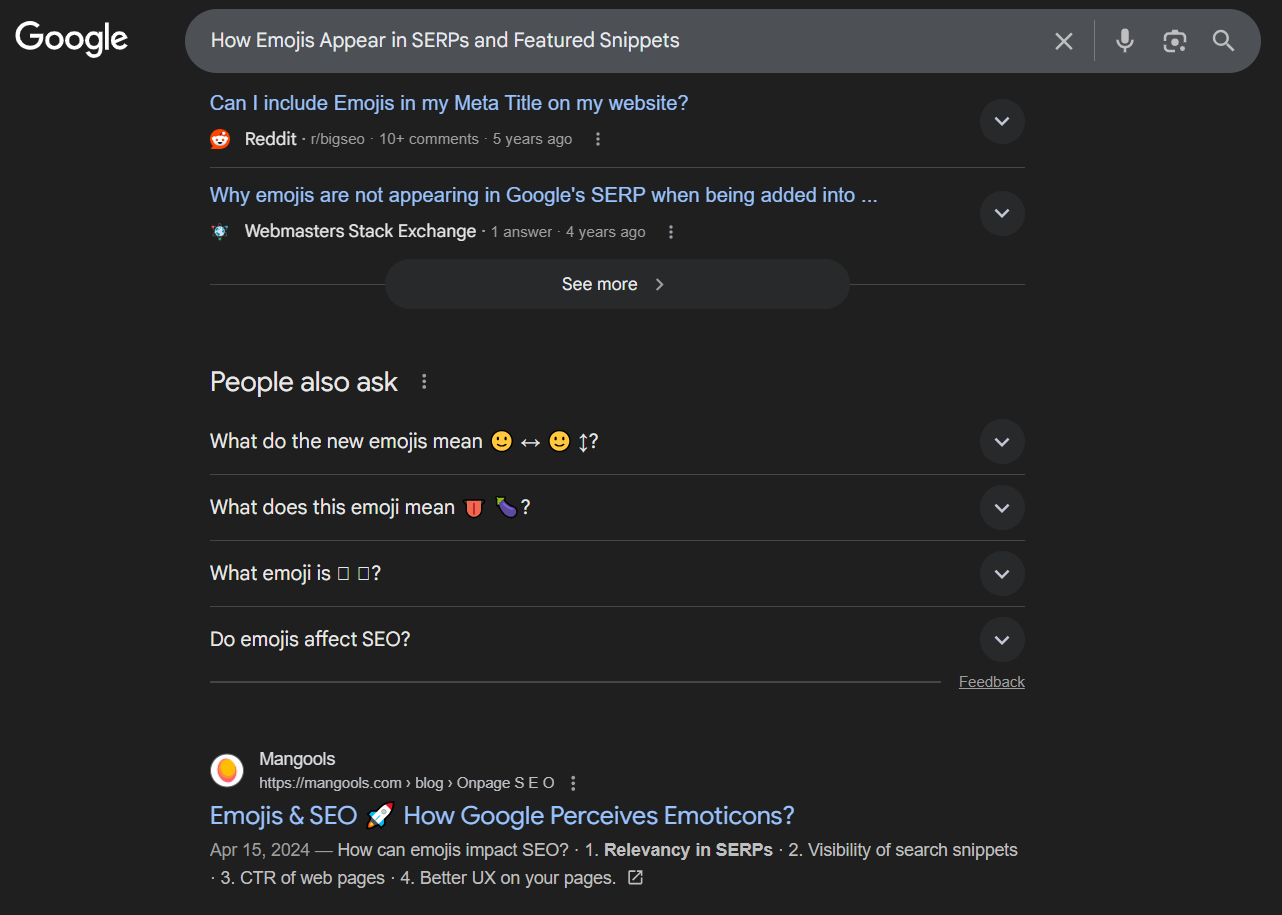
Source: Google
And here is how they appear in Featured Snippets:
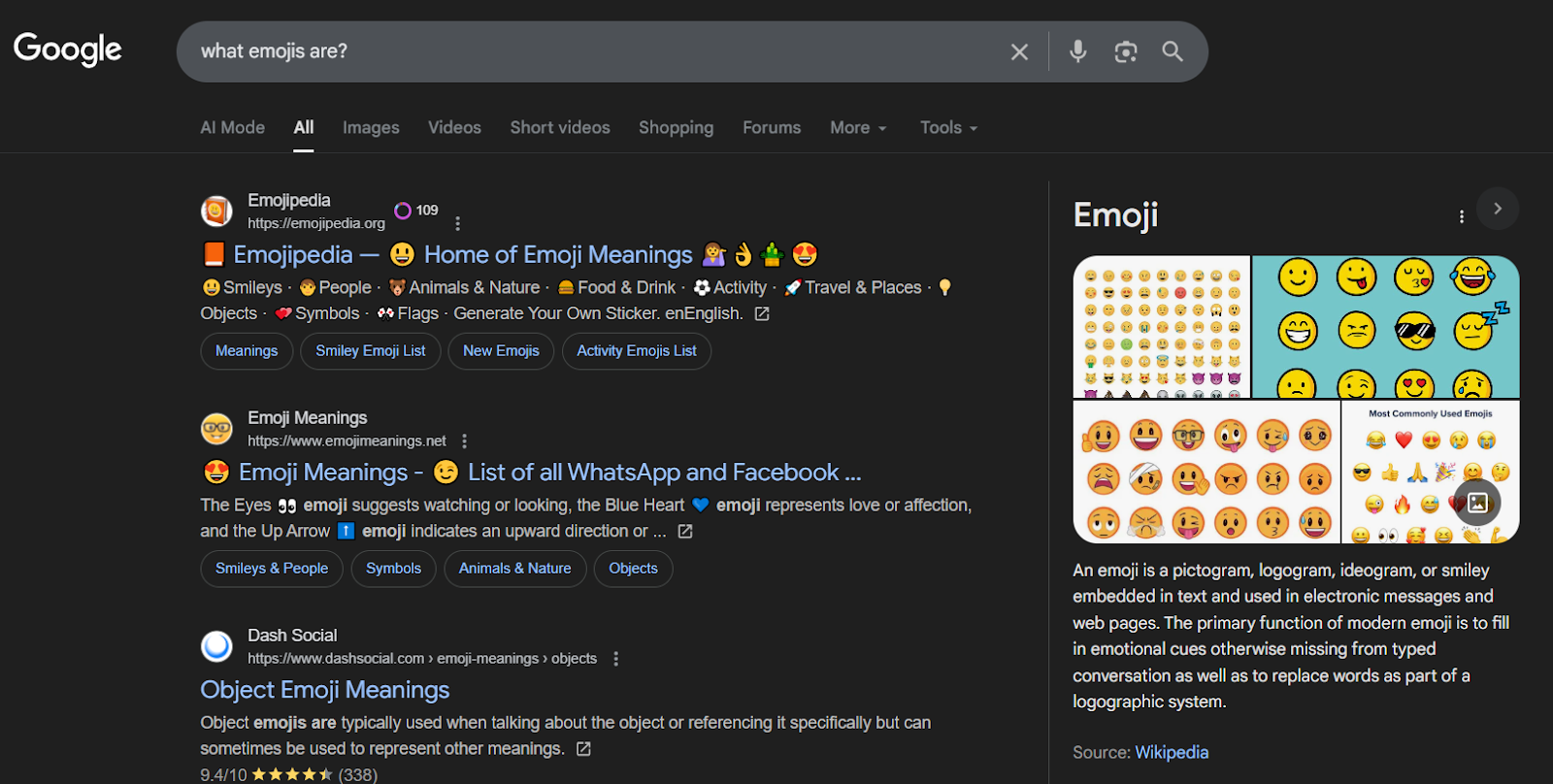
Source: Google
Google may also display emoticons in its latest feature that’s rapidly gaining popularity — AI Overviews. However, their appearance here is even rarer. The key to the display/no-display decision is relevance: if an expression visual is relevant, it gets displayed.
Icon Visibility Differences Across Devices and Platforms
Another common misconception among users and SEO practitioners alike is that their icons, once they get into SERPs and Google’s quick results features, will be displayed equally across platforms, devices, and cultures.
There are so many different emoji styles out there that it’s even logical to assume inevitable problems with their correct display.
These are the key differences to be aware of:
- Platform-defined design. Apple, Google (Android), Microsoft, and Samsung all have different icon styles. These differences can unintentionally alter the icon’s meaning and the mood it conveys.
- Browser rendering. Different browsers render graphical elements differently. The result is that an icon in Opera that displays a face shining with happiness, may look like just a smiling face in Chrome, or vice versa.
- Varied display support across platforms. A brand-new symbol may display perfectly on an Android system, but the same symbol would look like a black square on iOS. These collisions are also very common across MacBook and Windows users.
- Visibility in SERPs differs by device type. The mobile-first principle that most search engines follow often leads to a graphical item showing as intended on a user’s smartphone, but displayed as distorted or not displayed at all on desktop/laptop versions.
- Cultural and regional versions appear differently. Some platforms localize icons (like money bags or gestures) to reflect regional customs, which can affect user perception across markets and websites.
What does it all mean for your SEO? Basically, the key takeaway is that the display and meaning of an emoji can vary significantly depending on the user’s device, operating system, and even culture/geographic location.
You should test your emojis for visual appearance, and stick to the standard emoji styles as much as possible. Stay away from animated emojis and emojis in exotic and rare styles, as these factors definitely diminish your chances of successfully conveying the meaning to the end users.
Optimizing Content with Emojis: 8 SEO Strategies That Work
Given Google’s neutral stance towards emojis and apparent complexities with displaying visuals across devices and platforms, how to leverage them effectively? Do you even have any viable options at all?
It appears you, and everyone else, have plenty of opportunities to utilize emojis for the maximum SEO benefits. And in this chapter, we’ll show you how.
1. Using Symbols in Meta Titles and Descriptions
As we’ve learned, Google and other search engines neither welcome nor penalize the use of emoticons in meta titles and descriptions. However, users do appreciate the appearance of these little impression symbols in the texts, especially in headlines.
People don’t just read; they sort. Icons help them sort faster by hinting at format or vibe before they evaluate the rest of the snippet.
They also help differentiate similar results. In a sea of near-identical headlines, a small symbol says, “this is the guide,” or “this is the warning,” without adding extra words.
A meta description is what search engines appreciate. We write meta titles and descriptions alike for better search engine optimization. Why not put a single relevant emoji that underlines the value of your content in that 60 or 160 symbol limit text?
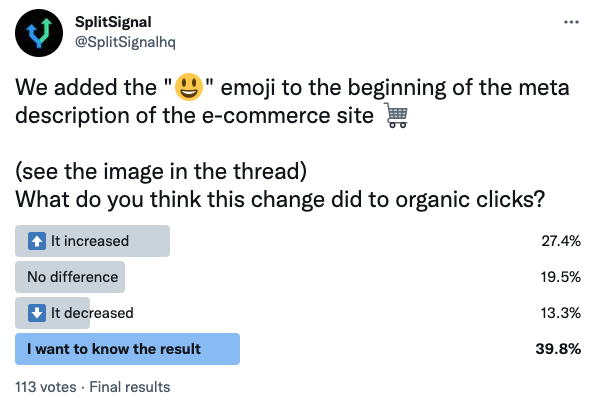
Source: SEMrush
2. Testing Emojis in Ad Copy and Rich Snippets
You don’t have to set one icon type and pray that it will show up in your PPC ad. While you certainly can, there are other, more effective methods like continuous testing. This method allows you to find the optimal type and style of icon that constantly shows up in Google’s SERPs and works the best for the users (drives CTR — click-through rate).
The following testing methods are available:
- A/B testing. This involves displaying two versions of an emoji at the same time and seeing in real time which one performs better. The one that survives the test stays.
- Visual type testing. The only difference with the previous method is that this time you test two visual versions, not two identical styles. For example, you test how a smile 🙂 icon performs vs a laughing 😄 icon, or how an angry 😠 type icon performs compared to an upset 😞 one.
- Position testing. As the name suggests, you test different positions of a visual item in your headline, text, meta description, and so on. Suppose an icon in the middle of a sentence drives a higher CTR than the one in the end — you proceed with the first option.
⚖️ The takeaway is clear: While emojis won’t improve your search ranking directly, they may do so indirectly, i.e., via user behavior. The behavior, however, does affect rankings over time, when users start to change your website metrics in your favor.
And the best way to make icons improve your Google ranking is to practice continuous testing and refinement, almost like a natural selection mechanism in nature: only the fittest emojis survive, and this process goes on and on.
3. Crafting Emotionally Driven Headlines with SEO Symbols
Headlines are the only pieces of content most people read. In the informational overload of the modern-day internet, reading everything is not even possible. You have to scan and cherry-pick only what truly interests you. And headlines work magic on this occasion.
A wisely put emoji in a headline helps drive attention, at least that brief moment when we lay our eyes on the piece of text. In most cases, that’s just enough.
For a website with overlapping topics, that tiny layer can guide the right visitor in and let the wrong one self-select out.
Headline ingredients that play well:
- A clear benefit first; the visual underlines it.
- Tone that stays consistent with the body copy to avoid dissonance.
- Brevity: fewer words leave room for one meaningful cue.
Cues are commitments. If the headline promises care, the page must show care.
📌 Respect that link, and put the symbol near the word that carries the promise. Also, remember about the compatibility nuances we’ve discussed in the earlier chapter, i.e., make sure you use the style of icons that is perfectly compatible with both mobile and desktop devices, as well as different operating systems and platforms.
4. Incorporating Emojis in Schema Markup
A schema of your website or page is a map for machines. When a symbol appears in the relevant schema fields, it should point to the meaning, just like a label would.
You’re giving parsers a hint, not a trick. Keep it truthful, minimal, and aligned with the visible content, and put the same clarity on the page itself.
Markup notes that hold up:
- Human-readable first: symbols that people understand are the only ones worth encoding.
- No stuffing: one cue per concept maintains legibility in excerpts.
- Parity: make sure the schema and page say the same thing in different layers.
Great markup is transparent; it explains rather than performs. Always prefer simplicity to excessive schema layout, put little for a better result. Sometimes it’s better to show no schema at all than to overstuff it with too many symbols.
5. Adding Emojis to Social Share Titles for Higher Engagement
Platforms like Facebook, X, LinkedIn, and others allow sharing a page in the form of a title, which acts like a micro-headline, capturing users’ attention. Why is it important? Because users don’t usually read deep into each title, they scan through the headlines, oftentimes every second or every third of them.
We are used to seeing titles in articles and blog posts, and even in SERPs with some context to them, e.g., an intro sentence or two, a short description, sometimes a whole paragraph.
However, on social networks, that context is missing due to space shortage. In that case, an expression icon compensates for the missing context, oftentimes conveying meaning better than a whole paragraph with text.
That superpower of an icon contributes to higher user engagement. For example:
- Title without symbol:
- Title with symbol:
How to Use LLMs for Blog Writing in 2025
💡 How to Use LLMs for Blog Writing in 2025
Both titles are identical text-wise. However, the second one with a symbol spikes emotions, it drives attention, and indirectly impacts user engagement. The chances are, you’ll get more clicks from the second title.
6. Optimizing Emoticons for Mobile-First Search Experiences
Most internet traffic can be attributed to mobile users. According to SQ Magazine’s research, mobile devices account for 59.6% of all global web traffic as of Q1, 2025. Other sources claim the share of mobile traffic to be even higher, up to 62.5%:
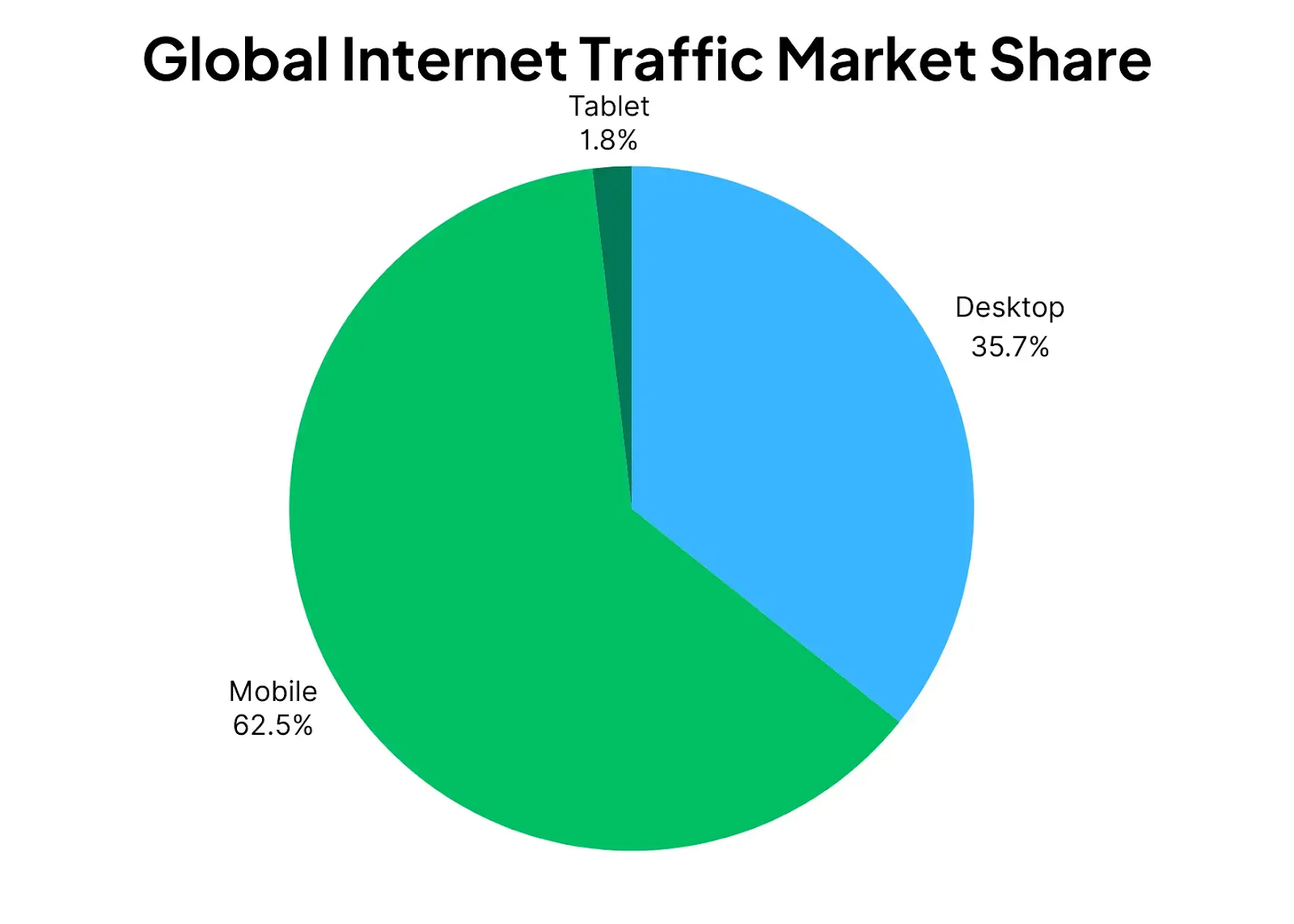
Source: Mobiloud
The implications for emoji SEO are huge. It means developers, content creators, and designers must optimize their SEO icons with a mobile user in mind. An expression icon that doesn’t display correctly on a mobile device is a serious handicap and a competitive downside.
Here are a few tips on how to optimize emojis for mobile-first search experiences:
- Use High-Recognition Symbols Only. Opt for symbols that utilize standard graphics and layouts; instead of exotic and obscure ones. Also, ensure the size of your icons is visible on mobile.
- Place the Icon Near the Core Keyword. That proximity and combination won’t affect search ranking, but it will positively influence how users perceive your content.
- Use One Icon Per Element. Remember how Birthday congratulations look when an overly empathetic friend sends one? A few words, but dozens of emojis may work for friends who know each other well, but it may cause misunderstanding or even repulsion in others.
- Choose Symbols That Match User Intent. Your icon must reinforce what the user wants. For example, a user looking for help will react positively to the 🙋♂️ icon, while the one looking for a free offer will get excited when seeing the 🎁 icon.
⚠️ If you want your icons to really work and produce the desired effect, test them regularly for engagement metrics. These include time on page, return visits, scroll depth, and other metrics indicative of the user’s interest.
7. Using Emojis in FAQ and How-To Schema
FAQ and how-to pages may not be the most crowded places; however, when visitors do access them, they expect to quickly find what bothers them and solve their problems.
Emoticons cannot solve users’ problems by themselves, but they do help connect with the content quickly on an emotional level. When used strategically, SEO icons in FAQ and how-to schema improve scroll depth, increase dwell time, and raise other engagement metrics critical for site performance, and, ultimately, conversions.
Here are a few tips on how to use chat symbols in FAQ/How-to guides effectively:
- Use distinct markers for each occasion and never mix the styles. E.g. a separate marker for a warning, pro tip, or the key takeaway.
- Combine emojis with plain phrasing, so that the simple-to-read icons complement easy-to-understand text.
- Use icons consistently (e.g., ❓ or 🤔 for a question mark, ⚠️ or 💡 for an important advice/tip), so patterns become easy to learn.
💡 Pro tip: Position your icons at the beginning of a sentence/heading, and avoid placing them at the end. The upfront positioning is more natural and triggers an immediate emotional response.
8. Combining Chat Symbols with Power Words for Emotional Triggers
Power words open the door; symbols choose the temperature of the room. Together, they help readers feel safe about the click.
So, combine power words with relevant emojis. In this case, using graphics at the end of the power word or phrase won’t hurt the perception (as power words are short and strong by definition).
Here are a few examples:
- Protect Your Data 🔒
- Save Time ⏳
- Improve Your Results ✅
- Checklist for Growth 📋
The following pairings usually travel very well:
- Safety words (protect, avoid) with steady, non-alarmist icons.
- Utility words (guide, checklist) with matter-of-fact visuals.
- Outcome words (save, improve) with calm confirmation symbols.
The key to success is harmony; there mustn’t be sharp contrasts in your pairings, nor repetitive icons across different power words.
💡💡 Pro tip: If you are not sure whether the power word-emoji combo will work well, try testing it with your colleagues or even running a small focus group with your audience.
Tools for Emoji Search Engine Optimization
Digital space is full of signals and data, sometimes too overwhelming, but it’s also full of tools and support. One can get plenty of support with emoji performance analysis and subsequent optimization, if one only knows where to look.
And this chapter is the right place to start. First, we’ll focus on how AI is helping emoji marketers with sentiment analysis, performance in SERPs, and in the end, we’ll discuss how emojis join forces with link-building to achieve even greater traffic acquisition.
AI and Sentiment Analysis in Emoji Marketing
If the famous Moore’s Law stated that computer power doubled every 18 months or so, the new AI technologies are doubling their computational power every 5.7 months. This exponential growth translates into more usage of AI tools and their deeper penetration into every sphere of our lives.
Marketing and customer sentiment analysis is no exception. AI is used widely to help marketers understand what drives consumer decisions. Interestingly, emojis play a big role here too. They assist smart algorithms in understanding whether a piece of content is supportive, positive, negative, neutral, and of any other emotional shade.
Modern AI systems (Google’s or LLMs like ChatGPT or Claude) are trained to track and analyze millions of patterns and data points. They relentlessly scan content for the cues that may indicate user intent. This includes how users react to icons in:
- Meta titles.
- Social posts.
- Reviews.
- Google Business Profiles.
- Product listings.
And when a user reacts more positively (or negatively) to a content that contains certain symbols, AI “brains” start to associate these reactions with engagement signals.
AI determines whether a piece of content is:
- Positive (😊 ✅ 🎉).
- Neutral (📌 🔍).
- Negative or cautionary (⚠️ 😠 🔥).
These emotional categories are not cosmetic — they influence discoverability, ranking signals, and whether your content is:
- Suggested in “related searches”.
- Featured in AI overviews.
- Shown more prominently in feeds or carousels.
🚀 Quick Takeaway. The increasing use of AI algorithms in user sentiment analysis and the role that emojis play here indicates that these little expression icons are much more than expressions; they are indirect (because Google officially doesn’t consider them to be ranking signals) ranking signals. They help your content speak in the language that the smart AI assistants understand.
Tools to Track Emoji Performance in SERPs
Emoticons are so ubiquitous that tracking them with your “naked” eyes would be overkill. You would need a whole division of human specialists sitting in front of the screens day and night, tracking and analyzing how icons perform in various pieces of content, across platforms, devices, and in SERPs.
Luckily, we are in the 21st century, and there are plenty of tools that can take over the unnecessary manual burden off your shoulders.
With emoticon performance in SERPs, you’d typically want to get the answers to these questions:
- Are those symbols actually appearing in SERPs?
- Are they visible across devices (mobile vs desktop)?
- Are they influencing user behavior (clicks, dwell time, share) even if they don’t directly influence ranking?
- Are there technical issues (icons not rendering, showing as boxes, in Google)?
Various tools allow you to answer these questions effortlessly. Here is a quick review of some of the most capable tools you should definitely try:
1. Ahrefs SERP Checker / Rank Tracker
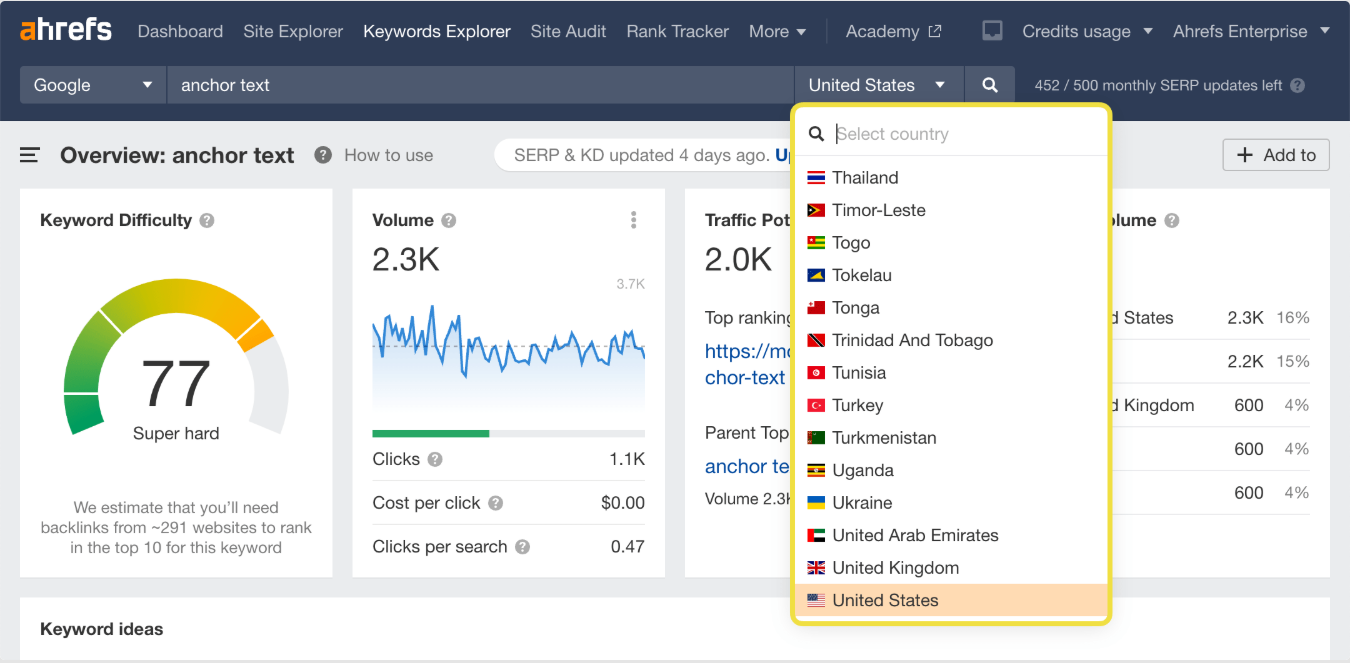
Source: Ahrefs
How it helps in this context:
- It lets you see how your target keywords rank in SERPs, for both desktop & mobile.
- It shows which pages rank and gives you metrics like backlinks, traffic estimate, and URL rating. It is useful to compare pages WITH icons vs WITHOUT.
- You can monitor visibility: if your page uses an icon in the title/meta, track whether its rank changes or user behavior signals improve.
2. SE Ranking Rank Tracker
This is a more specialized tool that will let you monitor and analyze how icons perform not only in SERPs in general, but also in their various features like Featured Snippets, People Also Ask section, Knowledge Panel, AI Overviews, etc.
It’s good for agencies and smaller teams (cost-effective). SE Ranking Rank Tracker features a built-in device and location segmentation that helps test icon display consistency.
Reports can include SERP features, which help you monitor whether your icon-rich snippets are getting enhanced result types.
Be aware of the two downsides, though:
- The tool doesn’t always show “icon appeared/didn’t appear” specifically.
- May require custom setup to track the icon aspect (you might have to track sample keywords manually).
3. SERPWatcher (by Mangools)
How it helps:
- Focuses on readability and user-friendly dashboards. Good for monitoring how certain content formats perform (icon vs no icon scenarios).
- Can help you compare the performance of pages that incorporate icons vs those that don’t — a kind of internal A/B style tracking.
The tool has a simple interface, which is good for smaller teams or solo marketers. It’s easy to read and understand which keywords got improvements or drops. You can also use it to track mobile vs desktop ranks.
Be aware of the few downsides, though:
- Again, not icon-specific about rendering.
- Fewer advanced features compared to large enterprise tools.
- If you track many keywords, cost and data volume might be limiting.
How Graphical Symbols Influence Link-Building and Natural Backlink Acquisition
Link-building is often used in paid ad campaigns, PPC, and other quick-result marketing activities. However, it also has a side to it that sets it apart from direct link acquisition in ads — it has the power to attract links in a natural way, i.e., organic link acquisition.
And that’s exactly where its paths intersect with emojis. The former are called expression icons for a good reason — they entice emotions (expressions) and, in doing so, help backlinks do their quiet magic. Both drive traffic to one’s website, increase authority and ranking.
While icons do not create backlinks on their own, they can directly affect the two things that do lead to natural link acquisition:
- Visibility.
- Emotional engagement.
By evoking strong reactions due to the presence of relevant visual elements, your content stands a better chance of being shared in forums and communities, cited in a blog post or newsletter, or included as a reference in research pieces.
In general, emojis contribute to natural link attraction in several ways:
- Boosting Click-Through Rates in Social Feeds
- Influencing Emotional Memory
- Encouraging User-Generated Links
- Enhancing “Link-Worthiness” Signals
Social feeds are crowded places, indeed, but icons can help cut through the noise and appeal to emotions faster and more effectively than any text can. That’s a strong factor for link acquisition.
Graphics can make you memorize better than plain text, which has been confirmed in many studies. Whatever triggers our emotions also inspires action — a strong case for the use of emojis in texts for natural link acquisition.
By copy-pasting content with links, users also grab icons along with it. That emotional anchor helps others quickly associate these symbols with a particular brand or product. And the more it gets shared, the easier it becomes for a wider audience to recall a particular brand name.
When your content ignites more engagement signals (higher dwell time, more clicks, lower bounce rate, etc.), it ranks higher in Google and other search engines’ SERPs. Higher rankings = higher link visibility.
📌 Key takeaway: Icons don’t generate backlinks directly. What they do is boost the visibility and discoverability of your content, which, in turn, enhances the chances of your content being liked, shared, and bookmarked.
SEO Icons for Social Media and Local Search
Social media and local search — two distinct SEO channels, yet they share many things in common with respect to how they utilize emojis for the benefit of increased content visibility and higher ranking.
In this chapter, we’ll explore different techniques used in emoji SEO to boost social media and local search results discoverability and rankings.
How Emojis Boost Discoverability on X, Instagram, and TikTok
Most social networks are places where people engage in casual conversations. These conversations are characterized by being informal and personal. They become easily influenced by visual cues such as small icons, where a single icon can define a mood: cheer up, make you smile, upset, distract, and so on.
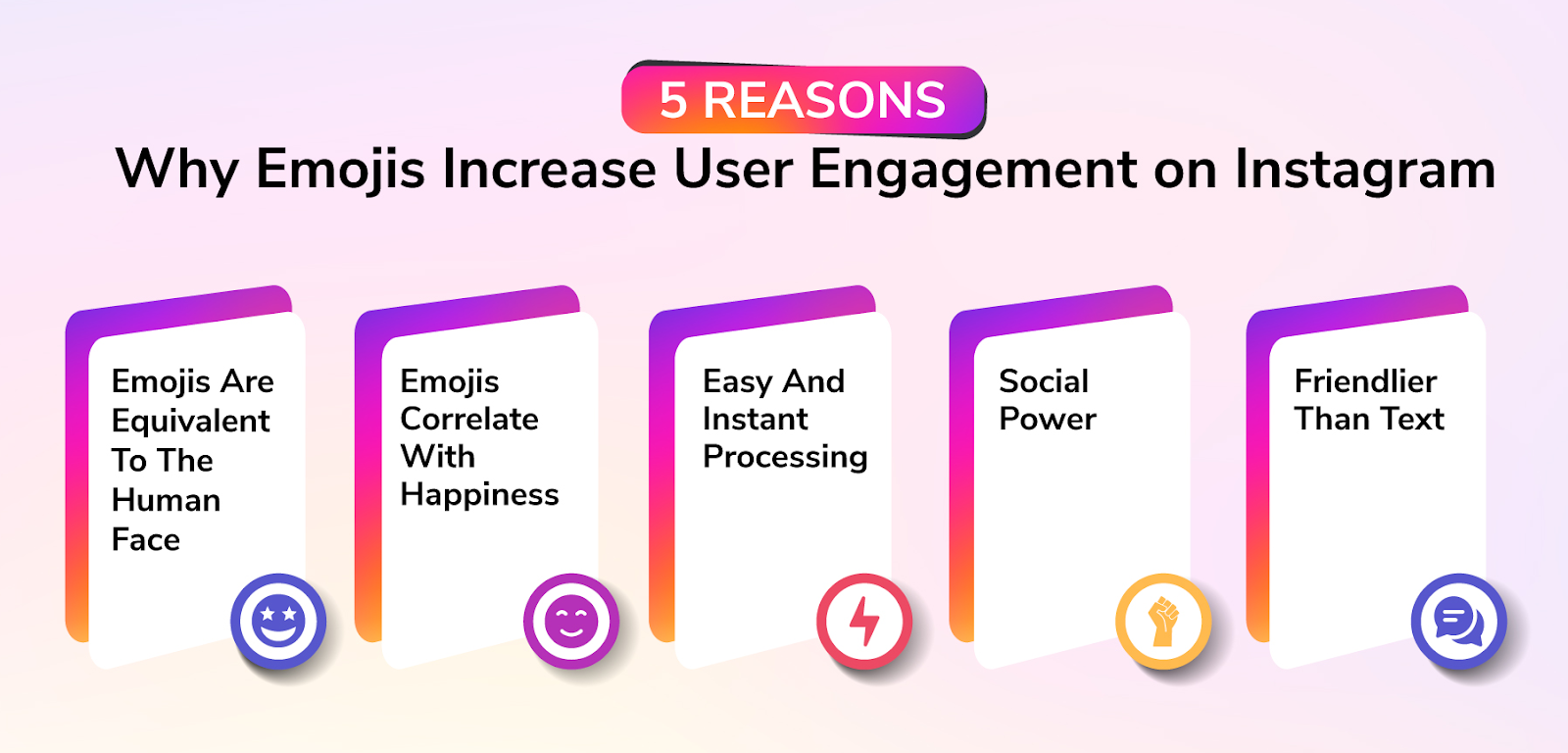
Source: Thunderclap
Billions of people scroll through social media feeds, and their attention is not so easy to capture. When you see endless texts with nothing to focus your eye on, the feed becomes almost insentient. But when in this sea of monotony a vivid icon pops up, it becomes a magnet for your tired eyes.
People process visuals faster than words (some even claim this process happens 60,000 times faster, but the real scientific evidence is scarce). In any case, a well-placed symbol on TikTok or X can grab interest even before the reader notices the text that follows.
💡 Pro tips: With emoticons on social media, less often means more, and too many can blur readers’ attention. Also, ensure maximum relevance, i.e., visuals should complement and enhance your words, not contradict.
Using Visual Symbols in Google Business Profiles for Local Impact
Contrary to the common misconception, Google Business Profiles (formerly Google My Business) aren’t only popular among businessmen. They are the doors and often become the first touchpoints that a casual user sees before opening a website or an online shop.
Emojis not only survive in GBPs; they thrive here! When information is scarce (and you do want your profile to have clear and succinct info), a visual anchor like an emoticon can effectively capture attention and entice a user to click on a relevant link nearby.
The following entries in GBP benefit the most from a strategic use of icons:
- Product listings.
- Service descriptions.
- Business posts.
- Contact information and opening hours.
- FAQ.
By adding a carefully chosen symbol next to a key phrase (like “Open 24/7” 🌙 or “Family-Friendly” 👨👩👧👦) you can quickly signal relevance to local users scanning through multiple similar options.
Even in GBP announcements, emojis work their silent magic. Here are some examples of effective uses:
- 🏥 Immediate Care Available.
- 🌱 Plant-Based Menu.
- 🎉 Event Space Booking.
- 🚚 Free Local Delivery.
📌 Key takeaway: Even more importantly than with social media, in Google Business Profile, icons should not overwhelm the listing. Instead, they should enhance visibility and save users a minute or two of reading a trivial text.
Aligning Emoji Usage with Brand Voice and Audience Demographics
Regardless of the application scenario or channel, the use of emojis must be relevant to the local audience and your brand voice. These are two distinct parameters, so let’s tackle them separately.
Aligning to the Brand Voice
The use of emoticons must be a continuation or enhancement of your brand. It should not contradict your values, mission, or vision.
For instance, it doesn’t make sense to use smiling or laughing icons for a business operating in the finance sector, selling financial products. A more appropriate set of emojis would include strict icon style, denoting numbers, relationships, and sending trust signals (📊, 💼, 🏛️, 🤝, 💹).
You shouldn’t be searching around the web for an appropriate symbol to use in your social media feed. Ideally, your PR or corporate communications unit should develop and publish a brand book with recommended communication styles and templates, including emojis.
Multiplying Impact by Matching Audience Demographics
Every audience is unique. This maxim works in business, marketing, sociology, and emoticology too 😃.
For a young audience, you’d use more cheerful, playful symbols that match their upbeat communication style (😄 🎉 🤩). Whereas, for the elderly people, your communication would be better off with more reserved and modest icon styles (📘 🤝 🕊️).
Other examples of icon-target audience fit include:
- Gen Z digital natives: 😎 🤳 🌈 🔥
- Millennial entrepreneurs: 🚀 💻 💡 ☕
- Corporate professionals: 📊 💼 🤝 🏢
- Parents and family-focused users: 👨👩👧 ❤️ 🧸 🏡
- Fitness and wellness seekers: 🧘♂️ 🏋️♀️ 🌿 💧
- Gamers and streaming communities: 🎮 🕹️ ⚡ 🧠
- Eco-conscious consumers: 🌱 🌍 ♻️ 🌿
- Foodies and culinary enthusiasts: 🍜 🍽️ 🍷 🔥
💡 Pro tip: Audience research should precede your communication, not the other way around. Sure, you can run test groups and see how certain graphics perform for each group, but mass communication must always be done with deep knowledge of the target audience and their preferences.
Common Mistakes and Risks
What can go wrong with emojis, you may think. Actually, many bad things can happen, but only if you keep on making the same mistakes and neglecting known risks. Let’s start with probably the most widespread mistake — overusing SEO graphics in meta titles and meta descriptions.
Overusing Icons in Meta Tags and Titles
The appetite to use more and more visual elements always comes slowly. It usually starts at the point where you don’t use any icons at all. Then you hear someone saying how effective they are, and you try adding some basic emojis.
As you practice more and more and become better at it, comes the real appetite or hunger, and in a short while, you end up overusing emoticons in small texts like meta titles and descriptions.
This, as we have learned earlier, starts to hurt your ranking. But not only that — it negatively impacts users’ engagement. When they see a few words surrounded by three symbols at the front, two in the middle, and five in the end, they suspect a scam and bounce off.
All sorts of problems appear with excessive visuals:
- Cognitive friction rises: users must decode icons before they can evaluate relevance.
- Consistency erodes: mixed symbol usage across pages confuses repeat visitors.
- Search engines often normalize flashy titles into plain text, so the effort invested in styling vanishes.
- A “try-hard” visual tone can erode brand authority in competitive SERPs.
The rule is restraint. One clear cue beats a string of mismatched ones. If the page cannot make a compact promise in plain text, dressing it with more icons won’t help.
Misinterpreted or Culturally Sensitive Emojis
We live in a multicultural world, where thousands of different traditions shape the unique mindsets of the people that inhabit each geographic area. Even a universal language such as English must be used with caution, as not all of its jokes and idioms are interpreted the same way as, let’s say, in the US or the UK.
Here is our list of the top 10 misinterpreted emojis across countries/cultures:
- 🙏 — Thanks or humble request in Western messages; in Asia, more like a respectful bow.
- 👍 — Thumbs-up = yes or good; a surprising insult in parts of the world.
- 👌 — “Perfect” in many chats; in Brazil/Turkey, not so perfect — actually offensive.
- 🤟 — Sign-linguistic “love” versus a heavy-metal or subculture symbol depending on place.
- 😘 — Romantic or friendly kiss — careful with formal audiences and conservative locales.
- 🙃 — Cheeky, ironic face in Western internet slang; elsewhere, just a smile turned upside down.
- 🎎 — Two dolls that, for many, point directly to Japanese tradition rather than generic festivity.
- 💐 — Presenting flowers: a joyful gift in many places, a sympathetic offering in some countries.
- 🐷 — Lighthearted pig in informal speech; sensitive or disrespectful symbolism in some religions.
- 🧿 — Nazar/evil-eye charm often read as protective in Greece/Turkey; mystic token elsewhere.
📌 Key takeaway: Before publishing any graphical SEO content, make sure it fits well with your target audience. You can simply Google each symbol to find the local interpretation, or ask someone from your customer base (the good old Customer Advisory Board works very well in this case) to give you honest feedback.
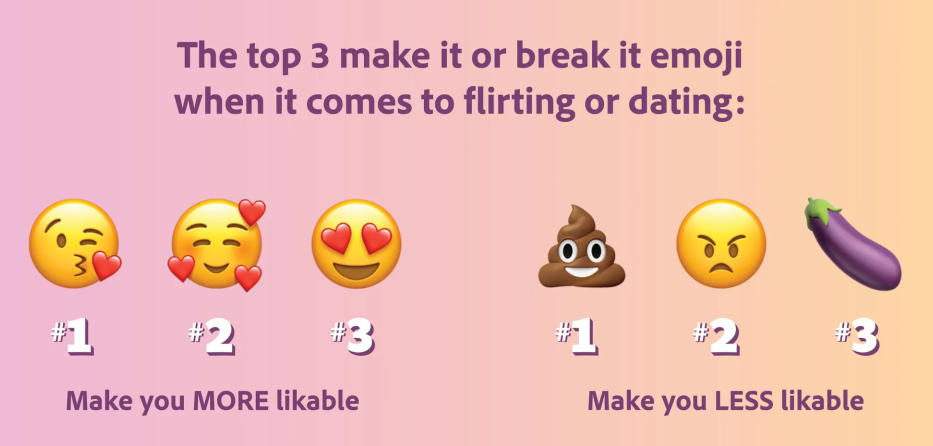
Source: Ktla
When to Avoid Emoticons Entirely
There are instances, however, when the use of emojis is not appropriate or highly undesirable. Sure, you always have a choice, but using expression icons may turn into more risks than benefits for your SEO. The damage done can range from typical metrics like visibility and rankings, but also touch on more profound things like your reputation and image.
Without further ado, here are some of the instances/scenarios when you should avoid emoticons entirely:
- Legal, financial, or regulatory disclosures.
- Crisis communications or incident reports.
- Medical or health-related advisories.
- Funeral, memorial, or condolence messaging.
- SERP titles for high-risk industries.
(e.g., tax statements, compliance pages, loan terms, insurance policies).
(e.g., safety warnings, system outages, public apologies).
(especially where clarity and seriousness override expressiveness).
(Symbols associated with these occasions can be perceived highly negatively, as amplifying one’s tragedy, or even insulting one’s feelings).
(in sectors like finance, law, cybersecurity icons may deter users, rather than attract and motivate).
📌 Key takeaway:Remember, SEO icons should amplify your content; not diminish its value, or damage your reputation. When in doubt, it’s better not to use any symbols at all to avoid possible risks.
Conclusion
Emoji SEO is such a powerful tool at your disposal. It can enhance the SEO value of your content, drive more “warm” (engaged) traffic, increase CTR and conversions, and, ultimately, drive your revenues.
On the other hand, excessive use of emoticons, or the use of inappropriate symbols, can cause you harm, hampering user perception, lowering search engine ranking, and damage your reputation. It’s like a hot spice — add a little, and your meal will taste better, but overuse it, and you won’t even want to put it in your mouth.
Never take the use of emojis lightly. It may seem like a trivial thing, but without prior research and relevant SEO tools, you won’t know where, when, and what type of icons will bring the maximum result and benefits.
Use the strategies shared here to deploy icons where they create real value, and avoid them when they put your credibility or performance at risk.
Enter URL & See What We Can Do Submit the form to get a detailed report, based on the comprehensive seo analysis.





